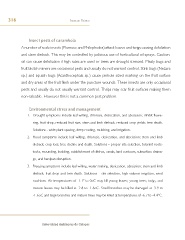Page 316 - FRUTAS DEL TRÓPICO
P. 316
316 Frutas del trópico
Insect pests of carambola
A number of scale insects (Plumose and Philephedra) attack leaves and twigs causing defoliation
and stem dieback. This may be controlled by judicious use of horticultural oil sprays. Caution:
oil can cause defoliation if high rates are used or trees are drought stressed. Mealy bugs and
fruit blotch miners are occasional pests and usually do not warrant control. Stink bugs (Nezara
sp.) and squash bugs (Acanthocephala sp.) cause pinhole-sized marking on the fruit surface
and dry areas of the fruit flesh under the puncture wounds. These insects are only occasional
pests and usually do not usually warrant control. Thrips may scar fruit surfaces making them
non-saleable. However this is not a common pest problem.
Environmental stress and management
1. Drought symptoms include leaf wilting, chlorosis, desiccation, and abscission; inhibit flowe-
ring, fruit drop, reduced fruit size; stem and limb dieback; reduced crop yields; tree death.
Solutions - wide plant spacing, deep rooting, mulching, and irrigation.
2. Flood symptoms include leaf wilting, chlorosis, desiccation, and abscission; stem and limb
dieback; crop loss; tree decline and death. Solutions – proper site selection, tolerant roots-
tocks, mounding, bedding, establishment of ditches, canals, land contours, subsurface draina-
ge, and hardpan disruption.
3. Freezing symptoms include leaf wilting, water soaking, desiccation, abscission; stem and limb
dieback; fruit drop and tree death. Solutions – site selection, high volume irrigation, wind
machines. Air temperatures of -1.1° to 0oC may kill young leaves; young trees, twigs, and
mature leaves may be killed at -2.8 to -1.6oC. Small branches may be damaged at -3.9 to
-1.6oC and large branches and mature trees may be killed at temperatures of -6.7 to -4.4°C.
Universidad Autónoma de Chiapas

